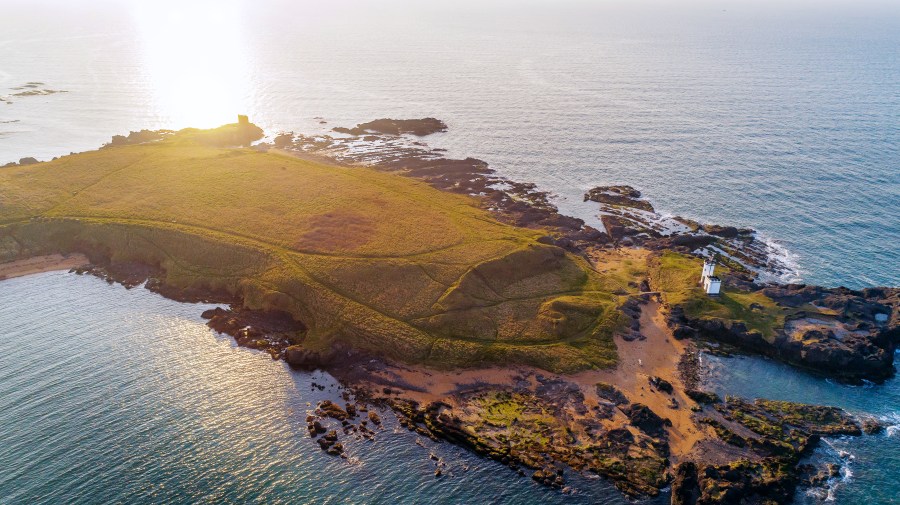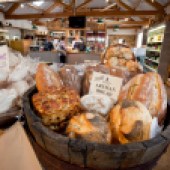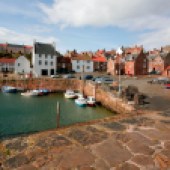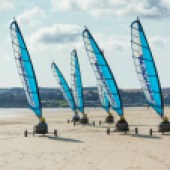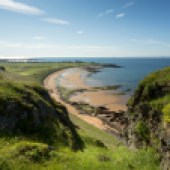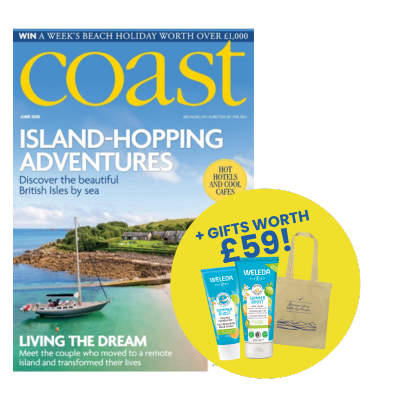Fife is an ancient Scottish Kingdom – a jigsaw of fascinating and beautiful places that join together to make one of the most perfect coastal destinations in the whole of the UK.
Many will enter Fife via one of the Forth Bridges – whether the striking Queensferry Crossing that brings cars and coaches across the firth or by rail over the UNSECO World Heritage site that is the iconic Forth Bridge.
It is just over 20 years since the creation of the Fife Coastal Path, Scotland’s longest continuous coastal path, that skirts the region’s stunning shoreline. Over the last two decades, it has been extended and now runs from its starting point upstream on the Forth at Kincardine, heading eastwards along 117 miles of path that takes you on a journey of discovery as it hugs the coast through historic towns, picturesque villages and working fishing harbours as well as through open countryside to reveal breath-taking scenery.
Managed and preserved by a local charity – the Fife Coast & Countryside Trust – it is split into eight bite-sized sections, but you are free to dip in and out to enjoy any stretch at any time – whether a short Sunday stroll or a more ambitious yomp.
Fife’s coast changes dramatically – from the more sheltered shorelines of the Forth and Tay estuaries to the exposed cliffs and beaches around the most easterly corner, known locally as the ‘East Neuk’.
It is a year-round destination – significantly drier than many coastal areas in the south of the country. Blessed by its easterly location, locals will tell you that this area is well known for dramatic skies – prevailing westerly rainclouds seem to head north or south as they pass over the area.
Let’s talk towns: along the shore you can discover Fife’s former industrial heartland – from Kincardine in the west to the former kingpin of Kirkcaldy. Smaller historic ports lie between the two – Culross, Charlestown and Inverkeithing among them – revealing the story of ancient maritime fortunes with castles and palaces on the route.
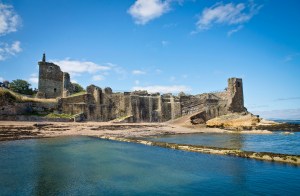
Perhaps the most famous of all Fife’s coastal towns is St Andrews – more than 600 years of golf and academia stand side by side, attracting people from all over the world. Modern day pilgrims who come to learn – whether on the fairways and greens of the famous links golf courses or in the classrooms and lecture halls of the University.
The railways opened up the coast to so many visitors in the 19th and early 20th centuries – making places easier to discover and explore. When the tracks were axed the fortunes of many declined. However, the 21st century has brought sustainable tourism – repurposing old railway lines as footpaths and cycleways as well as investing to re-open former lines, including Levenmouth Rail Link in 2024 – new tracks, new stations, electrification and connections with active travel partnerships.
Investment in the area goes beyond new transport – with a different kind of links. Dumbarnie Golf Links is the latest in a collection of internationally renowned courses that have been developed, undoubtedly in support of St Andrews as the ‘home of golf’ but now as ‘must play’ courses in their own right. That includes Kingsbarns Golf Links that enjoys a spectacular location on the shore near Cambo Gardens – a charity created in 2015 to “advance horticulture, heritage and arts”. The gardens are open year-round and visitors can also enjoy their Stables Cafe that serves vegetarian and vegan-friendly food. Both are dog friendly. There is also a stunning beach at Kingsbarns.
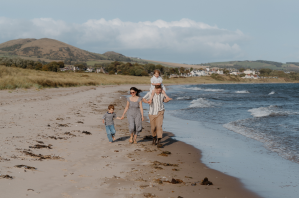
The phenomenal success of the 150th Open Championship in St Andrews in 2022 has seen thousands return to experience outstanding golf across the area. Pop a flag in the ground anywhere in north Fife and there are some 50 golf courses within an hour’s drive – from the iconic Old Course to many hidden gems such as Kingarrock hickory course and Cupar, believed to be the world’s oldest 9-hole course, in the ancient market town of Cupar.
The town of Leven is a lovely place to stop a while on the way to the East Neuk and a series of beautiful fishing villages that cling to the coast: Elie, St Monans, Pittenweem, Anstruther, Cellardyke and Crail. From Anstruther – or Anster as it is known locally – you can take a boat trip out to the Isle of May that’s home to more than 90,000 nesting puffins in the summer.
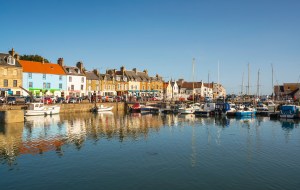
Clifftop walks on the coastal path link beaches and the harbours of each village – and between Shell Bay and Elie is the Chain Walk where chains embedded in rocks help the more experienced adventurers among us clamber over the rugged shoreline. In each village you’ll find fabulous places to enjoy world-class local food and drink. Enjoy the area’s outstanding seafood – whether in Michelin-starred restaurants, take-away fish & chips to eat on the harbour wall … or the latest catch bought straight from the fishmonger.
On the drinks’ front, you can discover award-winning distilleries – at Kingsbarns and Lindores – as well as a number of micro-breweries that have popped up over the last decade to meet the burgeoning demand for authentic, artisan produce.
You will also discover foodie destinations in their own right – such as Bowhouse, part of Balcaskie Estate. The estate can trace its history back through centuries and the venue they have created helps to connect growers and producers with restaurants and shoppers at a local level. You really don’t want to miss the monthly food market there.
Another on the ‘must visit list’ is Balgove Larder just outside St Andrews. Again, this has a deep-rooted history being part of the Strathtyrum Estate and the farm shop has its own butchery selling meat that’s reared on their farm as well as a unique steak barn and café serving dishes that focus on local, seasonal produce. The owner, Henry Cheape, is passionate about provenance. This winter he is undertaking the World’s Toughest Row – a solo 3,000 miles across the Atlantic powered predominantly by produce from his farm and farm shop.
For those who love adventure, you can experience outdoor water sports at East Neuk Outdoors in Cellardyke as well as with Blown Away, the company based on St Andrews West Sands beach who run sessions for surfing, sea kayaking, land yachting and more.
Continuing on the coastal path’s route north of St Andrews, you’ll pass Eden Mill at Guardbridge. The brewer and distiller is opening a new distillery and visitor centre in 2024, rekindling a whisky-making tradition that started on the site in 1655 but that has lain dormant for a century and a half.
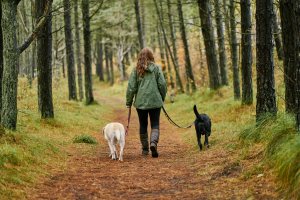
Beyond Guardbridge, explore the Tentsmuir National Nature Reserve. Tentsmuir Forest opens up onto miles of golden sands – often home to an array of wildlife including seals who bask on the sand bar that juts out from the River Tay into the sea. The forest has miles of crisscross trails and also includes a number of wildlife hides where you’ll spy red squirrels and migrating birds.
Around and into the Firth of Tay, discover the former ferry ports of Tayport and Newport that, before railways and roads, once shipped produce and passengers ‘to and fro’ the city of Dundee on the northern shore. Today, Newport has a ‘born again’ feel with an array of eateries that have sprung up since the V&A Dundee opened across the water, prominent among them The Newport, run by Masterchef winner Jamie Scott.
The remaining miles of the coastal path are among the most tranquil – following the south side of the River Tay through farms and woodland. Lindores Abbey Distillery is on this section – just outside Newburgh – and has revitalised the tradition of whisky-making that was first started by monks in the local abbey in 1494. Their history can be traced back for more than a thousand years. They sailed up the Tay and decided to make Fife their home. We can see why. Wherever you visit – and for however long – Fife will enchant you. You will enjoy many firsts and leave with a heart full of memories to last a lifetime.
Find out more and plan your next coastal holiday in The Kingdom, where it all begins www.welcometofife.com/thekingdom
Good to know …
Several sections of the coastal path are now pushchair and wheelchair friendly – with some sections being more challenging than others. Where the path follows the tide line, all are urged to plan ahead to make sure you are not affected by the rising seas.

